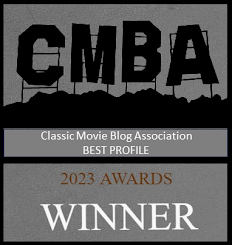Finally, every Holmes fan has a favorite film interpretator of the 221B Baker Street master detective. I've love to hear if you're a Rathbone afficionado, favor some of the one-time portrayers (e.g., Christopher Plummer in Murder By Decree), or go for a lesser-known one like John Nelville in the cult fave A Study in Terror. By the way, I like all of the movies just mentioned. But my two favorites are:
Throughout the late 1960s and early 1970s, I tried in vain in see the Basil Rathbone version of The Hound of the Baskervilles (1939). Every time it was listed in the newspaper, I’d tune in eagerly—only to see Hammer Films’ 1959 version starring Peter Cushing. I later learned that copyright issues prevented the Rathbone film from airing for many years. When it finally popped up on TV (on The CBS Late Movie, of all places), I was somewhat disappointed. Though Basil was entertaining as always, his Hound was surprisingly inferior to the 1959 version. Indeed, the Hammer Hound has improved with age, like a fine wine or, more appropriately, a glass of sherry (the vicar in the film has a fondness for it).
The opening scene is a spirited retelling of the legend of the Hound of the Baskervilles, with David Oxley shining as the utterly despicable Sir Hugo Baskerville. After the hound disposes of Sir Hugo, we learn that Dr. Mortimer is telling the tale to Holmes and Watson at 221B Baker Street. It's a shrewd way to introduce the backstory and inject some action in what it is basically a low-key mystery.
The rest of the plot follows Conan Doyle’s novel fairly faithfully. Indeed, the minor variations in the adaptation make the story more interesting. The climax is a bit disappointing. The vicious hound, when finally glimpsed, turns out to be a Great Dane with a leather mask on its head. When it attacks one of the villains, you can see the actor grab the dog as it starts to run by him.
Still, The Hound of the Baskervilles is a highly enjoyable affair. Peter Cushing makes a superb Holmes, all nervous energy as if his brain can barely contain his superior intellect. His interpretation is every bit as good as Basil Rathbone’s more acclaimed one. Andre Morrell plays Dr. Watson straight, instead of providing comic relief (as Nigel Bruce, whom I still love, did in the Rathbone films). His Watson is intelligent, affable, and observant—very much like the character in Conan Doyle’s novels and stories.
Director Terence Fisher was on a roll, having previously helmed Hammer’s Dracula (1958) and Curse of Frankenstein (1957). As he did in those films, Fisher brings a colorful atmosphere and brisk pacing to the Holmes mystery. He also carefully masks the film’s modest budget. Listen closely and you can hear James Bernard’s music from Dracula being recycled. Also, the night scenes look very much like twilight or late afternoon (of course, even Hitchcock had trouble making night scenes look dark enough in color).
Ironically, Christopher Lee (who played Sir Henry Baskerville) would take his turn as the Great Detective in the mediocre German film Sherlock Holmes and the Deadly Necklace (1962). Cushing played Holmes again in a short-lived British TV series. Sadly, Hammer could never secure the rights to make additional Holmes films with Cushing and Morrell. (TCM will show it Dec 26, 2:45 am EST.)
With his sharp features and abrupt delivery, Rathbone made an ideal Holmes—his interpretation is still considered the standard by which all others are measured. Although Bruce’s Watson is nothing like the cultured physician in the detective stories, the actor remains immensely likable and provides memorable comic relief. In addition to The Hound, Rathbone and Bruce made a well-received sequel, The Adventures of Sherlock Holmes. Then, unexpectedly, Twentieth Century-Fox decided to end its Sherlock Holmes series.
In 1942, Universal convinced Rathbone and Bruce to reprise their roles in a series of 12 Holmes pictures. These movies featured smaller budgets than the Fox films and, most significantly, they updated the action to modern day. In addition to his arch nemesis Professor Moriarty, Holmes got to battle the Nazis (Sherlock Holmes and the Voice of Terror) and dabble in espionage (Sherlock Holmes and the Secret Weapon). The best of the Universal series—indeed one of the best of all Holmes films—is The Scarlet Claw.
All but the opening scene takes place in La Morte Rouge, a small Canadian village surrounded by marshes and enshrouded in fog. Holmes and Watson go there in response to a letter from a dead woman (well, she wrote it while she was alive). The detective duo soon discover a trail of corpses and a glowing phantom that runs across the marshes at night. Oh, yes, and the murderer turns out to be a master of disguises, too.
There is much to like in The Scarlet Claw. Although never shown, the murders are appropriately grisly. In one scene, Holmes displays the five-pronged garden tool used to rip open the victims’ throats. The “ghastly apparition” on the marshes hints of a supernatural explanation. The settings, particularly the murderer’s riverside house, are impressive for a backlot film. And, above all, director/co-writer Roy William Neill compresses the mystery into a well-paced, compact 74 minutes. Like all the Holmes films produced during World War II, The Scarlet Claw ends with a patriotic wartime ode, this one a tribute to Canada.
The other Holmes films in the Universal series pale in comparison to The Scarlet Claw. Still, several of them are enjoyable little mysteries, in particular Sherlock Holmes Faces Death, House of Fear, and The Pearl of Death. (TCM will show it Dec 26, 12:15 pm EST.)









